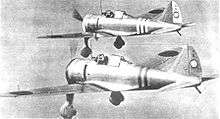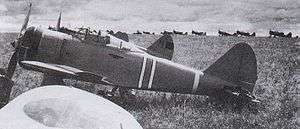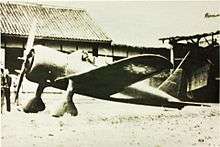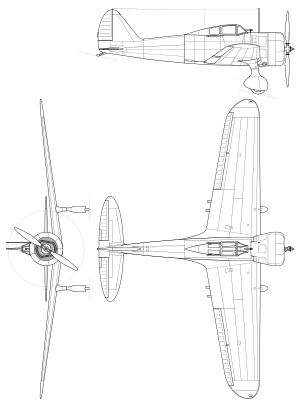Nakajima Ki-27
| Nakajima Ki-27 | |
|---|---|
 | |
| Nakajima Ki-27 | |
| Role | Fighter aircraft |
| Manufacturer | Nakajima Aircraft Company |
| Designer | Yasushi Koyama |
| First flight | 15 October 1936 |
| Introduction | 1937 |
| Retired | 1945 (Japan) |
| Primary users | Imperial Japanese Army Air Force Manchukuo Air Force Royal Thai Air Force Reformed Government of the Republic of China |
| Number built | 3,368 |
|
| |

The Nakajima Ki-27 (九七式戦闘機 Kyūnana-shiki sentōki, or Type 97 Fighter) was the main fighter aircraft used by the Imperial Japanese Army Air Force up until 1940. Its Allied nickname was "Nate", although it was called "Abdul" in the "China Burma India" (CBI) theater by many post war sources;[1] Allied Intelligence had reserved that name for the nonexistent Mitsubishi Navy Type 97 fighter, expected to be the successor to the Type 96 carrier-borne A5M with retractable landing gear and an enclosed cockpit.[2][3]
Design and development
In 1935, the Imperial Japanese Army held a competition between Nakajima, Mitsubishi, and Kawasaki to design a low-wing monoplane to replace the Kawasaki Ki-10 (Army Type 95 Fighter) biplane. The new fighter was to have also a better performance than the experimental Mitsubishi Ki-18.[4]
The results were the Nakajima Ki-27, the Kawasaki Ki-28, and the Mitsubishi Ki-33 (a modification of the Mitsubishi A5M carrier-based fighter).[5][6] The Nakajima design was based on its earlier Ki-11 monoplane fighter which lost to the Ki-10 in the Type 95 Fighter competition. When the follow-up Nakajima Ki-12 proposal with a liquid-cooled engine and retractable landing gear was deemed too complex by the Japanese officials, the Ki-27 was designed by Koyama Yasushi to have an air-cooled radial engine and fixed landing gear. The aircraft had the Nakajima trademark wing with a straight leading edge and tapered trailing edge which would reappear again on the Ki-43, Ki-44, and Ki-84.
The Ki-27 made its first flight on 15 October 1936.[7][8] Although it had a slower top speed and worse climb performance than its competitors,[9] the Army chose the Nakajima design for its outstanding turning ability granted by its remarkably low wing loading. The Army ordered 10 pre-production samples (Ki-27a) for further testing, which featured an enclosed cockpit with sliding canopy and larger wings.
The type was officially accepted into service in 1937 as the Army Type 97 Fighter. In addition to Nakajima, the Ki-27 was also manufactured by Tachikawa Aircraft Company Ltd and Manshukoku Hikoki Seizo KK, with a total of 3,368 built before production ended in 1942.

Operational history
The Ki-27 was the Imperial Japanese Army Air Force's main fighter until the start of World War II. When placed into combat service over northern China in March 1938, the Ki-27 enjoyed air superiority until the introduction of the faster Soviet-built Polikarpov I-16 fighters by the Chinese.

In the 1939 Battle of Khalkhin Gol against the USSR in Mongolia, the Ki-27 faced both Polikarpov I-15 biplane and Polikarpov I-16 monoplane fighters. In the initial phase of the conflict, its performance was a match for the early model I-16s, and was considerably superior to the I-15 biplane. With better trained Ki-27 pilots, the IJAAF gained aerial superiority. The Ki-27 was armed with two 7.7 mm (.303 in) Type 89 machine guns and as with most aircraft of the period, lacked armor protection for the pilot and self-sealing or fire suppression in the fuel tanks.
Later, the Soviet Air Force received improved I-16s. The faster, more heavily armed (with twin wing-mounted 20mm ShVAK cannons) and armored I-16 now nullified the Ki-27's advantages and it could now escape from the Ki-27 in a dive. The VVS introduced new tactics consisting of flying in large tightly knit formations, attacking with altitude and/or speed advantage and hit-and-run (high-energy) tactics much as Claire Chennault would later formulate for the 1941-era Flying Tigers (likewise to fly against Japanese forces).
Japanese losses mounted but despite this they claimed 1,340 aircraft (six times the admitted Soviet losses and three times as many as Soviet aircraft admitted to being in the theatre),[10] though similar discrepancies were common worldwide before gun cameras became widespread. Japanese losses numbered 120 (including Ki-10s) while the Russians claimed 215 vs. a peak Japanese strength of 200 fighters.[10] Top scoring pilot of the incident and top scoring IJAAF pilot on the Ki-27 and overall World War II IJAAF ace was Warrant Officer Hiromichi Shinohara, who claimed 58 Soviet planes (including an IJAAF record of 11 in one day) whilst flying Ki-27s, only to be shot down himself by a number of I-16s on 27 August 1939.[11]
The preference of Japanese fighter pilots for the Ki-27's high rate of turn caused the Army to focus excessively on manoeuvrability, a decision which later handicapped the development of faster and more heavily armed fighters. The Ki-27 served until the beginning of World War II in the Pacific, escorting bombers attacking Malaya, Singapore, Netherlands East Indies, Burma and the Philippines (where it initially fared poorly against the Brewster F2A Buffalo).[12]
The type also saw extensive action against the American Volunteer Group in the early months of the war. Soon outclassed by the American Curtiss P-40 Warhawks, the Ki-27 was replaced in front line service by the Nakajima Ki-43, while surviving examples continued to serve as a trainer.
The Ki-27 was also exported for use with Manchukuo and Thai armed forces, seeing combat with both. In Thai service, Ki-27s reportedly damaged two North American P-51 Mustangs and shot down one Lockheed P-38 Lightning.[13]
In the final months of the war, desperate lack of aircraft forced the Japanese to utilize all available machines and the Ki-27 and 79 were no exception. Some were equipped with up to 500 kg (1,100 lb) of explosives for kamikaze attacks, but some were redeployed as fighters, suffering terrible losses as on 16 February 1945 when the 39th Educational Flight Regiment scrambled 16 Ki-79 trainers from Yokoshiba Airfield to oppose a massive air raid from U.S. Task Force 58 carrier group, losing six aircraft with more damaged and five pilots killed, in return damaging at least one Hellcat and possibly downing a second.[14]
Variants
Data from[15]
- Nakajima Army Type 97 Fighter
- Long Army designation for the Ki-27
- Nakajima Type PE
- Private-venture experimental aircraft with Nakajima Ha.1a engine.
- Nakajima Ki-27
- Prototype version with armament in response to IJAAF specs, two aircraft built.
- Nakajima Ki-27-Kai Prototype
- Pre-production units with armament and heavier Ha.1b engine, 10 aircraft built.
- Ki-27a
- First production version. Approximately 565 aircraft built.
- Ki-27a-Kai
- Trainer version converted from existing production. Approximately 150 aircraft converted.
- Ki-27b (Army Type 97b Fighter)
- Improved canopy, oil cooler and provision for 4 × 25 kg (55 lb) bombs or fuel tanks under the wings. A total of 1,492 built, including 50 by Tachikawa Aircraft Company Ltd.
- Ki-27b-Kai
- Trainer version converted from existing production. Approximately 225 aircraft converted.
- Nakajima Ki-27-Kai
- Experimental lightened version developed as an interim solution when Ki-43 development was delayed, top speed 475 km/h (295 mph); two aircraft built[16]).
- Mansyū Ki-79
- Trainer version, built by Manshūkoku Hikōki Seizo KK with a 510 hp Hitachi Ha.13a-I or Ha.13a-III engine. A total of 1,329 aircraft built in four sub-versions (The single seat Ki-79a (Ha.13a-I) and Ki-79c (Ha.13a-III) and the two-seat Ki-79b (Ha.13a-I) and Ki-79d (Ha.13a-III)[17][18]).
- Mansyū Army Type 2 Advanced Trainer
- Long Army designation for the Mansyū Ki-79
Operators
World War II
- Imperial Japanese Army Air Force[19][20][21]
- No. 2 Dokuritsu Hikō Daitai IJAAF
- No. 9 Dokuritsu Hikō Chutai IJAAF
- No. 10 Dokuritsu Hikō Chutai IJAAF
- No. 84 Dokuritsu Hikō Chutai IJAAF
- No. 102 Dokuritsu Hikō Chutai IJAAF
- No. 1 Hikō Sentai IJAAF
- No. 2 Hikō Sentai IJAAF
- No. 4 Hikō Sentai IJAAF
- No. 5 Hikō Sentai IJAAF
- No. 9 Hikō Sentai IJAAF
- No. 11 Hikō Sentai IJAAF
- No. 13 Hikō Sentai IJAAF
- No. 18 Hikō Sentai IJAAF
- No. 21 Hikō Sentai IJAAF
- No. 24 Hikō Sentai IJAAF
- No. 26 Hikō Sentai IJAAF
- No. 29 Hikō Sentai IJAAF
- No. 30 Hikō Sentai IJAAF
- No. 33 Hikō Sentai IJAAF
- No. 48 Hikō Sentai IJAAF
- No. 50 Hikō Sentai IJAAF
- No. 54 Hikō Sentai IJAAF
- No. 59 Hikō Sentai IJAAF
- No. 63 Hikō Sentai IJAAF
- No. 64 Hikō Sentai IJAAF
- No. 68 Hikō Sentai IJAAF
- No. 70 Hikō Sentai IJAAF
- No. 77 Hikō Sentai IJAAF
- No. 78 Hikō Sentai IJAAF
- No. 85 Hikō Sentai IJAAF
- No. 87 Hikō Sentai IJAAF
- No. 101 Hikō Sentai IJAAF
- No. 144 Hikō Sentai IJAAF
- No. 204 Hikō Sentai IJAAF
- No. 206 Hikō Sentai IJAAF
- No. 244 Hikō Sentai IJAAF
- No. 246 Hikō Sentai IJAAF
- No. 248 Hikō Sentai IJAAF
- Rikugun Koukuu Shikan Gakkō
- Tokorozawa Rikugun Koku Seibi Gakkō
- Akeno Rikugun Hikō Gakkō
- Kumagaya Rikugun Hikō Gakkō
- Tachiarai Rikugun Hikō Gakkō
- Scheduled aircraft never delivered due to distrust of Chinese forces[22]
Post-War

- In 1945, Indonesian People's Security Force (IPSF) (Indonesian pro-independence guerrillas) captured a small number of aircraft at numerous Japanese air bases, including Bugis Air Base in Malang (repatriated 18 September 1945). Most aircraft were destroyed in military conflicts between the Netherlands and the newly proclaimed-Republic of Indonesia during the Indonesian National Revolution of 1945-1949.
Survivors
Two aircraft survive today:
- One Ki-27 is preserved at the Tachiarai Peace Memorial Museum.[25][26]
- One Mansyu Ki-79 is preserved at the Satria Mandala Armed Forces Museum, Jakarta, Indonesia.[27]
Specifications (Ki-27b)

Data from "Nakajima Ki-27 Nate"[20]
General characteristics
- Crew: one, pilot
- Length: 7.53 m (24 ft 8 in)
- Wingspan: 11.31 m (37 ft 1¼ in)
- Height: 3.28 m (10 ft 8 in)
- Wing area: 18.56 m² (199.777 ft²)
- Empty weight: 1,110 kg (2,588 lb)
- Loaded weight: 1,547 kg (3,523 lb)
- Max. takeoff weight: 1,790 kg (3,946 lb)
- Powerplant: 1 × Nakajima Ha-1 Otsu air-cooled radial engine, 485 kW (650 hp)
Performance
- Maximum speed: 470 km/h (292 mph)
- Cruise speed: 350 km/h (218 mph)
- Range: 627 km (390 mi)
- Ferry range: 1100 km (682 mi)
- Service ceiling: 12,250 m (32,940 ft)
- Rate of climb: 15.3 m/s (3,010 ft/min)
- Wing loading: 83.35 kg/m² (18 lb/ft²)
- Power/mass: 0.30 kW/kg (0.18 hp/lb)
Armament
- Guns: 2 × 7.7 mm Type 89 machine guns, 500 rounds/gun or 1 x 12.7 mm Ho-103 machine gun and 1 x 7.7 mm machine gun on later models
- Bombs: 100 kg (220 lbs)
See also
| Wikimedia Commons has media related to Nakajima Ki-27. |
- Related development
- Aircraft of comparable role, configuration and era
- Related lists
- List of military aircraft of Japan
- List of aircraft of Japan, World War II
- List of aircraft of World War II
References
Notes
- ↑ Francillon 1979, p. 202.
- ↑ Wieliczko and Szeremeta 2004, p. 87.
- ↑ "Nakajima Ki-27 (Nate / Abdul)." militaryfactory.com. Retrieved: 5 October 2009.
- ↑ Januszewski 2003, p. 10.
- ↑ Januszewski 2003, pp. 10–11.
- ↑ Wieliczko and Szeremeta 2004, p. 12.
- ↑ Francillon 1979, p. 198.
- ↑ Wieliczko and Szeremeta 2004, p. 16.
- ↑ Wieliczko and Szeremeta 2004, pp. 17–19.
- 1 2 Francillon 1979, p. 200.
- ↑ Sakaida 1997, pp. 16–17.
- ↑ Wieliczko and Szeremeta 2004, p. 57.
- 1 2 Wieliczko and Szeremeta 2004, p. 81.
- ↑ "Cat Fight Over Chiba". Tailhook Magazine. 1997. Archived from the original on 2013-01-19.
- ↑ Bueschel 1970, p. rear cover.
- ↑ Francillon 1979, p. 203.
- ↑ Francillon 1979, p. 486.
- ↑ Wieliczko and Szeremeta 2004, pp. 26–27.
- ↑ Bueschel 1970, pp. 48–50.
- 1 2 Wieliczko and Szeremeta 2004, p. 99.
- ↑ Thorpe 1968, pp. 1881–185.
- ↑ Bueschel 1970, p. 50.
- ↑ "Japanese Aircraft in Royal Thai Air Force and Royal Thai Navy Service During World War II." aeroflight.co. Retrieved: 22 July 2010.
- ↑ Wieliczko and Szeremeta 2004, p. 79.
- ↑ "Nakajima Ki 27 'Nate' at Tachiarai Peace Memorial Museum." j-aircraft.com.Retrieved: 14 August 2012.
- ↑ Wieliczko and Szeremeta 2004, p. 77.
- ↑ "Mansyu Ki-79b at the ABRI Satria Mandala Museum." pacificwrecks.com. Retrieved: 22 July 2010.
Bibliography
- Bueschel, Richard M. Nakajima Ki.27A-B Manshu Ki.79A-B in Japanese Army Air Force-Manchoukuo-IPSF-RACAF-PLAAF & CAF Service. Reading, Berkshire, UK: Osprey Publications, 1970. ISBN 0-85045-020-9.
- Francillon, Ph.D., René J. Japanese Aircraft of the Pacific War. London: Putnam & Company, Second edition 1979, First edition 1970. ISBN 0-370-30251-6.
- Green, William. Warplanes of the Second World War, Volume Three: Fighters. London: Macdonald & Co. (Publishers) Ltd., Seventh impression 1973, First edition 1961. ISBN 0-356-01447-9.
- Green, William and Gordon Swanborough. "The Agile Asian... Japan's Type 97 Fighter". AirEnthusiast Six March–June 1978. Bromley, Kent, UK: Pilot Press Ltd., 1978.
- Green, William and Gordon Swanborough. WW2 Aircraft Fact Files: Japanese Army Fighters, part 2. London: Macdonald and Janes's, 1977. ISBN 0-354-01068-9.
- Januszewski, Tadeusz. Mitsubishi A5M Claude. Sandomierz, Poland/Redbourn, UK: Mushroom Model Publications, 2003. ISBN 83-917178-0-1.
- Kotelnikov, Vladimir R. Air War Over Khalkhin Gol: The Nomonhan Incident. Bedford, UK: SAM Publications, 2010. ISBN 978-1-906959-23-4.
- Mikesh, Robert. Japanese Aircraft 1910-1941. Annapolis, Maryland: Naval Institute Press, 1990. ISBN 1-55750-563-2.
- Nedialkov, Dimitar. In The Skies of Nomonhan, Japan vs Russia May–September 1939.. London: Crecy Publishing Limited, Second edition 2011. ISBN 978-0-859791-52-6.
- Sakaida, Henry. Japanese Army Air Force Aces, 1937-45. Botley, Oxford, UK: Osprey Publishing, 1997. ISBN 1-85532-529-2.
- Tapasanan, Vidya. "Japanese Airplanes in the Royal Thai Airforce (RTAF) Service." Asahi Journal No. 4/2002.
- Thorpe, Donald W. Japanese Army Air Force Camouflage and Markings World War II. Fallbrook, California: Aero Publishers, Inc.,1968. ISBN 0-8168-6579-5.
- Wieliczko, Leszek A. and Zygmunt Szeremeta. Nakajima Ki 27 Nate (bilingual Polish/English). Lublin, Poland: Kagero, 2004. ISBN 83-89088-51-7.